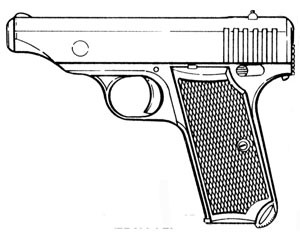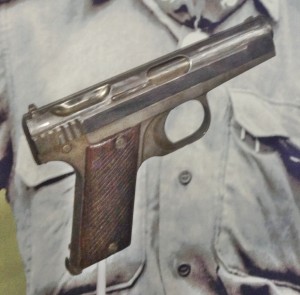The story of the Hamada pistol starts in 1895, when the Hamada Gun Shop was opened on Tokyo, and soon became well known for excellent quality hunting rifles and shotguns manufactured on site. The shop owner’s son Bunji Hamada was born in 1901, and became active in the shop at a young age, proving to be a very talented gunsmith in his own right. The shop continued to make high-end sporting arms until 1941, when the supply of material became too heavily restricted by wartime demands. At that point, the shop turned to military production. The standard Japanese Type 14 Nambu pistol was expensive to manufacture, and importation of American and European small pistols (traditionally favored by Japanese officers) had dried up because of the war. A cheaper substitute pistol was needed, and Hamada produced a design which beat several competitors to win an Imperial Army contract.

Hamada’s pistol, designated simply “Hamada Type” was heavily based on the Browning 1910 automatic pistol. It offered an increased magazine capacity of 9 rounds, and was chambered for the .32 ACP cartridge (many other .32 ACP pistols were in use with Japanese forces). It was produced from 1941 until February 1944 in Hamada’s Tokyo shop, with a total of 4500-5000 being made. All of these were sent to China, which explains their scarcity in the west today. Only 27 are documented to exist over here, and they are all between serial numbers 2214 and 2959. Very likely a small group of Japanese soldiers who were issues Hamada pistols were transferred from China to the Pacific islands, and a few of their pistols captured by US soldiers and brought home. All the other .32 caliber Hamadas were either destroyed or remain in China.
These first group of Hamada pistols showed excellent standards of quality in their manufacture and finish, as one would expect from a company with a reputation built on high-end sporting guns. A number of details about the gun were changed throughout the production run, including the number of slide serrations, grip panel design, serial number marking style, and a few others.
Hamada Type 2
Named for its initial design in 2602 (1942 in the Gregorian calendar), the Type 2 Hamada was an adaptation of the original gun to 8mm Nambu. The military was slower to adopt this 8mm version, apparently because of tension between military ordnance officers and the notably non-military lineage of Hamada and his pistol. Several variations were made to the gun through a back-and-forth series of trials, and by incorporating several preferences of the Major running the Army Technical Research Institute responsible for adopting the gun, Hamada finally got it accepted. The gun was basically a scaled up version of the original, with the final version featuring a longer barrel, steeper grip angle, and magazine capacity reduced to 6 rounds. The pistol was formally adopted by the Japanese Army in June of 1943.
A particularly distinctive feature of the Type 2 Hamada is the pair of semicircular cutouts made to the rear top of the slide, to reduce its weight. These are clear on the Type 2 that Weaponsman photographed at Fort Bragg:

Interestingly, this particular example is one of the very last prototypes made prior to serial production. It is marked “1” on several parts, and remains unfinished in the white.
The Hamada had been originally purchased as a way to reduce costs in pistol procurement, but as with so many military projects worldwide, the cost had inflated by the time they were ready for production. Ultimately the cost for a Type 2 was found to be 164 yen 98 sen each, (compare this to the Type 94 Nambu, which was allocated 80 yen per unit). A textile factory in Notobe was modified for pistol production with the assistance of the Nagoya arsenal, and the Type 2 was manufactured there from February 1944 until the end of the war.
In exchange for the assistance setting up the factory, the Hamada pistols were to go through bluing and final inspection at Nagoya’s Toriimatsu factory. The first batch of 500 guns were delivered to Toriimatsu in 1944, and another thousand by the end of the war. However, Toriimatsu only recorded delivery and processing of the first batch of 500. The first 50 of those were set aside for some reason, and guns form this batch make up all of the 17 known Type 2 Hamadas known to still exist in the US. The remaining 450 were probably sent as a group to a single unit in China, and either lost there or sunk en route by US submarines. The remaining thousand or so guns built but never blued have never been accounted for. Most likely, they were destroyed at the end of the war as scrap, although it is possible they were simply issued in the white as demand for guns became more desperate.
Hamada Himself
Bunji Hamada survived the war, having moved from Tokyo to the factory at Nobuto in 1944. When the war ended, he opened the Hamada Gun and Powder Shop in Kamakura City, where he returned to his passion for building hunting rifles. Japan’s gun laws kept it as a small shop, but Hamada continued to run it until his retirement in 1977. He was interviewed by Harry Derby and James Brown (authors of the standout encyclopedia of Japanese handguns, Japanese Military Cartridge Handguns 1893-1945, from which this information is taken) in 1981, at which time he was still actively competing on the shotgun range using a 12ga over-under he had manufactured in 1927 (the first model of over-under shotgun made in Japan) We don’t have any information on Hamada-san’s death, but he would be 111 years old today if he still survives.

I have a 12 GA. Manville Gas Gun from the original 1935 version that shoots 24 rounds……Rare! Includes original case & two pistols…….
Neat! Can you please post pictures?
Huh, I didn’t know there was a streamlined and logically simplistic handgun in the Imperial Japanese arsenal. Shows what I know.
Sounds like a very interesting fellow by the way, I wish we could know more about him.
Fascinating. But really only a drop in the bucket of wartime production. I wonder if Hamada-sen’s sporting arms ever made it to America. His was a small shop but he did have a long career. Perhaps his caliber choices would be too much trouble for american sportsmen? Though, because of the occupation and SEATO I imagine he would have made many rifles in U.S. calibers? I was under the impression that civilian firearms ownership was all but non-existent in Japan.
All, thanks for sharing the Hamada gun history. Plan to visit his family gun shop next month through a friend from our local Sportsmens Club. I hope to get some pictures of the pistols and bits of gun history to share.
I recently acquired a Winchester Model 12 from an estate broker. It is ornately engraved. The sales tag says “Special Engraving by Hamada, 1955”. Beautiful Gun!
I have a Model 12 I believe was also engraved by Hamada and Sons. Do they sign their work?
I have my fathers Winchester model 12 with scrollwork from what we are pretty sure was Hamada and sons from ~1958. Curia if you ever got any more info regarding your question?
Interesting to know if any of Hamada Hunting rifles and shotguns are still around ?
How would you identify an engraved gun by Hamada and Sons?.
We have number 18 known to exist-serial number 41
I just picked up an original Japanese Hamada brown leather shoulder holster in excellent condition. all I need now is a pistol.anyone know where I can find one.
Just purchased serial number 25. Why were the first 50 found fully assembled for bluing?